Is Roberto’s New Uovo the One Ring To Rule All Ligatures?
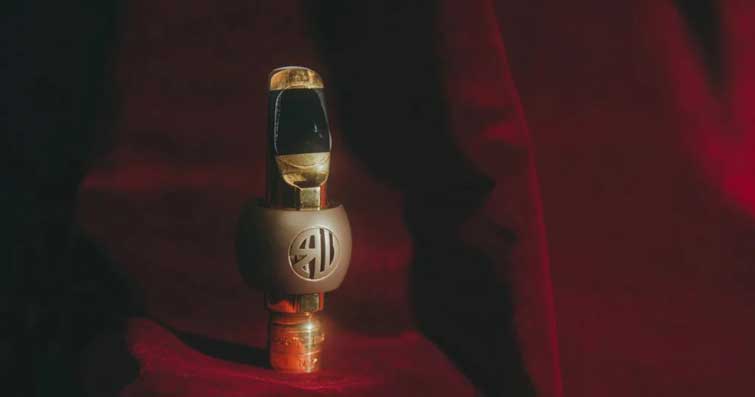
Introduction
One of the first saxophone-centered stores I ever visited was Roberto’s Winds. I remember when I first visited, the Vandoren V16 hard rubber line of mouthpieces for tenor and alto sax had just come out, in addition to Roberto’s Reeds and earlier versions of their wooden ligatures
Quite recently, in addition to reeds, ligatures, neckstraps, and even their own line of saxophones, Roberto has released a metal ligature called the “Uovo” (woh-voh) which was designed for all metal tenor mouthpieces, but in particular for players who played metal Otto Links.
Nicky Romeo (Roberto’s son) was nice enough to send me the Uovo ligature to further play-test and get my initial thoughts. Although, I mainly play on hard rubber tenor mouthpieces, I was nonetheless curious to see how the Uovo compared to other ligatures that are on the market today. For those of you who have not heard of the Uovo or wonder how it’s different, read on for a brief overview.
Product Overview
The Roberto’s Uovo ligature was designed, “to generate sympathetic resonance, enriching the harmonic palette to enable your very best sound”. The Uovo ligature is 3D-Printed using stereolithography machines and is cast in bronze which provides Otto Link and all metal mouthpiece players a ligature that sings.
With the Uovo ligature comes four plates (2 bronze, 2 sterling silver) to accommodate different sound preferences and resistance levels. The contact points with the plate and the reed send vibrations to the shell, which intensifies the depth and body of the harmonics.
Finally, the Uovo is a fully adjustable headless screw and self-tightening system which retains your adjustment settings indefinitely. The Uovo Ligature starts at $295 with the brass plate, $325 with the Sterling Silver Plate and finally $425 if you are looking for the complete set which I will be reviewing today (See final thoughts for additional details).
Review
Packaging
I would not normally bring up the packaging of a product, but when I received the RW Uovo ligature, I was quite surprised.
When I opened the package, I thought “was I sent multiple boxes of reeds, a couple mouthpieces, and multiple ligatures”, but no, it was a fancy box to put it simply (see picture below) that contained the Uovo ligature, four plate options, a mini screw driver with a wooden handle, an allen wrench, a unique red cap to accommodate the Uovo’design, a red cloth with the Uovo logo, and finally a red false reed plate. In addition to the accessories that came with the Uovo, it also contained a step-by-step guide how to change plates out as well as adjust as you place the lig on your mouthpiece.
All in all, really nice packaging to compliment the ligature but I would personally utilize a much simpler packaging from a cost standpoint since there is some great material/video content online for how to use the Uovo ligature, and this most likely would result in a lower cost to Roberto’s as well as the player.
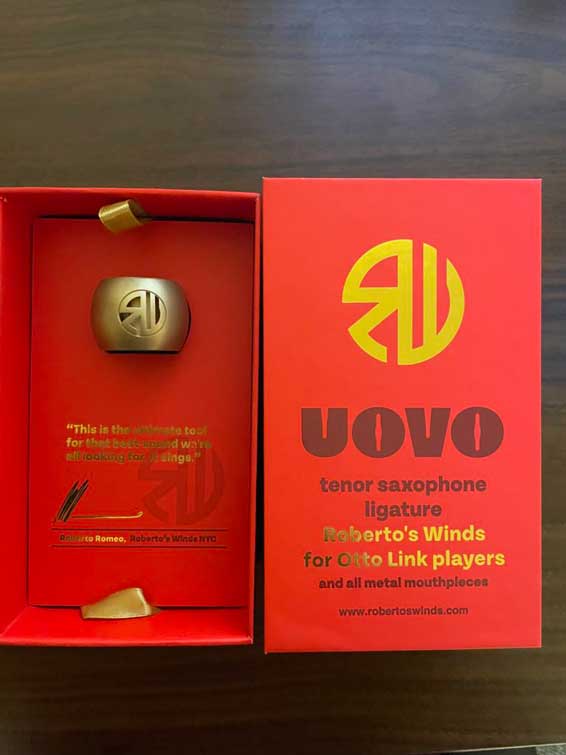
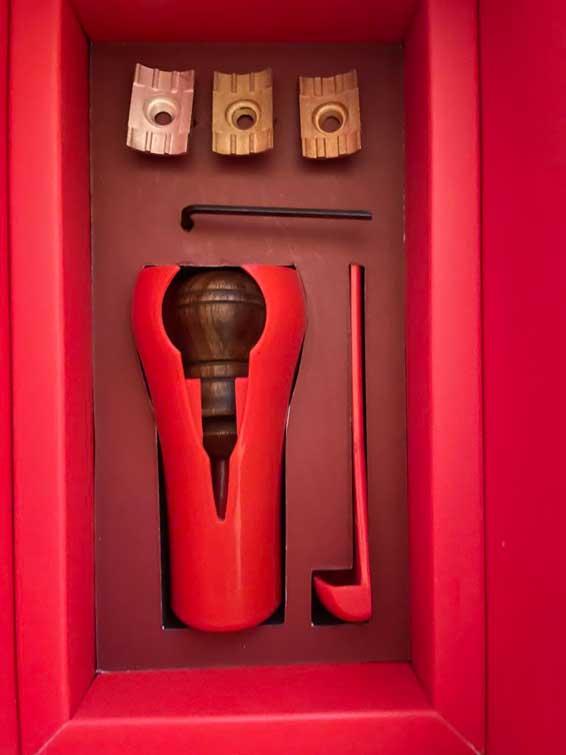
Build/Quality
The design and build quality of the Uovo ligature is not an ordinary simple ring ligature. Roberto came up with the vision for this ligature and collaborated with Tommaso Troncon, mouthpiece maker, re-facer, and the designer of the Uovo ligature.
Tommaso shared that the manufacturing process for this ligature is quite unique. High-end 3D printers were leveraged to manufacture waxes, which are then taken and cast in one piece which is finally laboriously worked by hand.
By leveraging this process, you end up with no solder points, resulting in a very resonant material that is sturdy and will not bend, crack, or fold under intense pressure.
The Uovo ligature is made of bronze, and I noticed that the Uovo is at the top of the ligature, there is a line or rail cut out which was designed to accommodate the Otto Link mouthpieces. In addition, inside the ligature on the left, right, and bottom, you see a circular cut-out with a star-like symbol which reminds me of the death-star from Star Wars. I believe these cut outs are what Roberto’s is referring as the creation of an acoustic chamber.
The plates at the bottom of the ligature can be swapped out with the screwdriver and allen wrench. Two of the plates are bronze and two are sterling silver and. Taking a closer look, you’ll notice that two of the plates have the same design, but the two middle touch points on the front and back of the reed plate are wider, while with the other (almost identical) design the front and bottom touch points are thinner lines (see photo below).
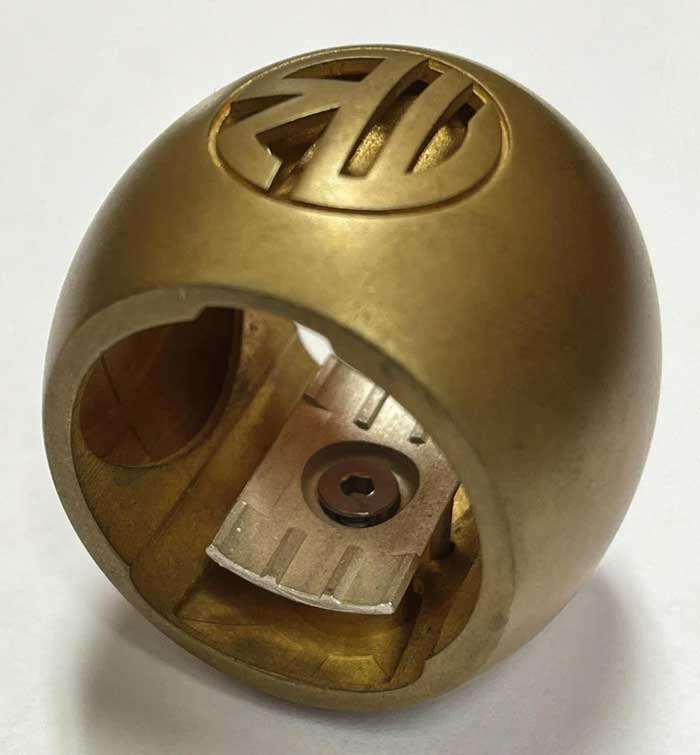
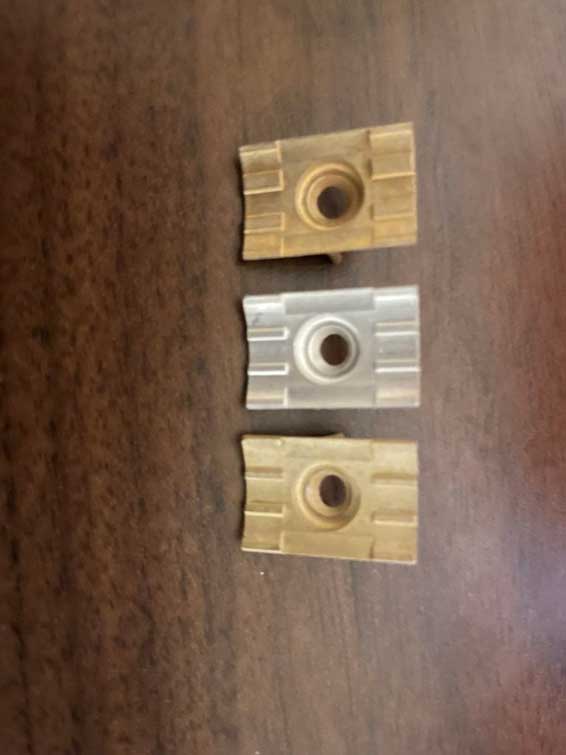
Fit/Adjustment
I was able to test the Uovo ligature on a few metal Links (Florida & early Babbitt) as well as a vintage Dukoff Stubby mouthpiece (thanks to Tim Lin), and the ligature fit fine but did take some time to get used to. What I will say is that when you first receive the Uovo ligature, please watch the video instructions online and read the guide/pamphlet that comes in the box with the Uovo, because if you don’t, you will most likely find adjusting as well as tightening this ligature on your mouthpiece to be challenging and somewhat frustrating (I was using the wooden screwdriver which was not the right way to adjust this ligature).
Here is a link to Roberto’s site where you can check out a video that clearly demonstrates how to raise or lower the plate: https://www.robertoswinds.com/pages/uovo
My recommendation, per the video demonstration, is to place your mouthpiece on your neck, then place the reed on the mouthpiece and finally use your index finger on the top and thumb on the bottom, touching the screw to turn the mouthpiece either counterclockwise to raise the plate, or clockwise to lower the plate. Once you find the position that matches your reed, place the Uovo on your metal mouthpiece to secure the reed.
What I experienced before watching the video is if you do not follow this process, then once you place the Uovo on your metal mouthpiece, you will find you are not able to further tighten the plate to secure the reed, and will end up using the screwdriver to further tighten the plate which is not a process I’m sure anyone wants to repeat every time.
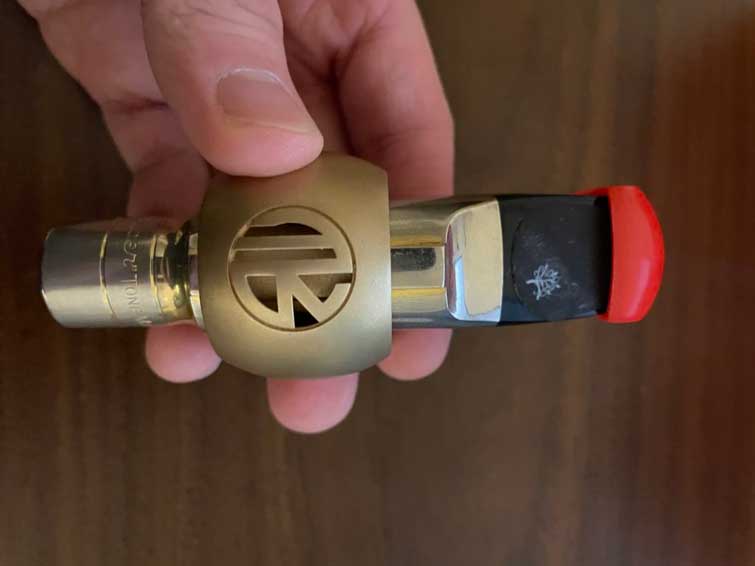
Sound/Playability
Now when it comes to the ligature’s effect on your setup in terms of playability and overall sound, this can be quite subjective. What I will say is I was able to play test the Uovo on a vintage Florida link and compared it’s playability/sound to a Selmer 404 ligature, Rovner Dark Ligature and Vandoren Optimum ligature.
- My experience with the Selmer 404 ligature was the playability was pretty even throughout the entire range of the horn. The Link with the 404 ligature spoke well and I did notice in comparison to the other ligatures that the Selmer 404 had a slightly, to my ear at lease, brighter and thinner top end.
- My experience with the Rovner Dark Ligature was the playability was pretty even like the 404, but the overall response was duller and darker throughout the entire range of the horn. The Link with the Rovner Dark ligature seemed to be less direct and focused as the 404, and more spread with less edginess and buzz.
- My experience with the Vandoren Optimum Ligature was the Optimum playability in comparison to the 404 and Rovner was the most even from top to bottom. Sonically I found this combination to be in the middle (neutral). The sound was more centered than the Rovner Dark Ligature and a bit less bright in the higher-end in comparison to the Selmer 404.
- My experience with Uovo Ligature was that in comparison to the other ligs mentioned in this list, Uovo did have the most buzz or responsiveness from playing from low Bb to High F# and beyond. Sonically, I found the Uovo to be neutral like the Vandoren Optimum ligature, but it was more responsive overall, without changing the back-pressure or resistance, which I liked. Across the range of the horn, I heard more lows, mids and highs, and regardless of whether I was pushing a lot of air through the mouthpiece or played softly, I felt the Uovo maintained a fat core sound across vs being more spread or thin like the Rovner.
Now when it came to play testing the four plates to see which one I preferred, I did not hear a significant difference sonically between the bronze and sterling silver plates, but I did find that I preferred the two plates (bronze and sterling silver) with the second and third rail on the front and back of the plate being thicker, as I found the additional contact between the rails and reed seemed to provide a little bit more resistance.
That said, please note this was my experience with an Otto Link, and testing out on a Dukoff Stubb, it may be different to play test these plates on different metal mouthpiece such as a JodyJazz, Ted Klum, Vandoren V16, 10mFan, Retro Revival, etcetera.
Tommaso did mention that from their testing, the sterling silver plates, despite having the same dimensions, is denser. This results in a difference in resistance. From his testing, he found the plates that were sterling silver to have a cleaner sound. The thickness of the central second and third contact points on the front and back of the plate resulted in a thinner rail being more free blowing while the thicker rail added some resistance
Final Thoughts
I want to thank Nicky Romeo for sending me the Uovo ligature to further play test. Although a ligature might seem like a small factor with a primary purpose being fastening the reed to your mouthpiece, it can also be an important factor in simply allowing the reed to vibrate as efficiently as possible with your setup so you can have the best playing experience possible.
Now, when it comes to a ligature for the Vintage or Modern Otto Link mouthpieces, I do like the Uovo’s cut out rail design, as it provides one of the better fits in comparison to other ligatures currently on the market.
Probably, like you, one of the first questions that came to mind was the high price point. At $425 dollars, this ligature falls in the very high-end price range in comparison to other options which can range from $50+ dollars for a Vandoren Optimum or Selmer 404 Bird, to $150+ if you are looking at a Ishimori Woodstone Ligature, Silverstein, or EchoMaster (vintage Brilhart copy) ligature to just name a few. To put it simply, if you are currently playing a metal mouthpiece for tenor (especially a Link), and are struggling to find a ligature that fits and holds the reed securely without dampening or restricting the sound, then I would recommend giving the Uovo Ligature a try if your budget allows. On the other hand, if you do not have a budget that allows for the Uovo’s price point, then I simply don’t think the Uovo ligature will be the best fit for you, and you may want to consider some of the other options I mentioned above.
Additional Uovo Reviews
Steve Neff Uovo Ligature Review





